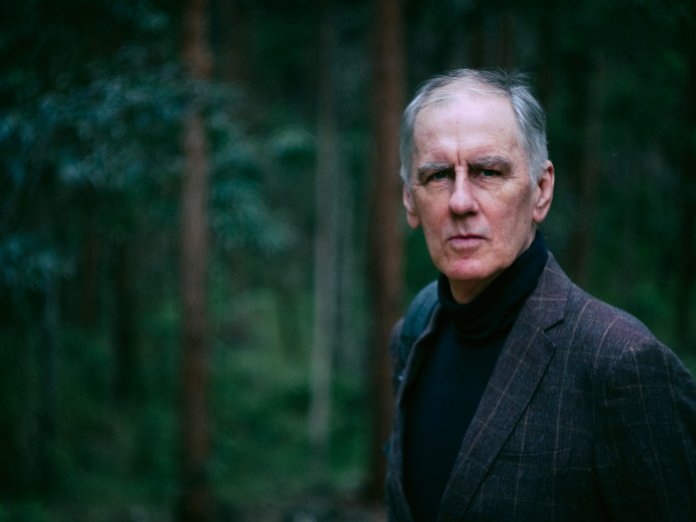In 2006, following the death of his Go-Betweens foil and best friend Grant McLennan, Robert Forster stopped making music and, for a time, chose to write about it instead. A book, The 10 Rules Of Rock And Roll, collected the essays he wrote for Australian publication The Monthly – and introducing the collection was the list of commandments with which it shared its title. In the fourth of these rock rules, Forster declared, “Being a rock star is a 24-hour-a-day job.”
You’re reminded of this edict when you watch the video for “Tender Years”, the second song on Forster’s eighth solo album. In the kitchen of the Brisbane house he shares with his wife Karin Bäumler, we see Forster miming to the song as he commences his daily breakfast ritual, making muesli for himself and Bäumler. And because being a rock star is a 24-hour-a-day job, it’s a performance to which he absolutely commits, ensuring he’s chopped the papaya in time to pick up his air guitar for the solo.
This is Forster in excelsis. A rock star happy in captivity, singing a sustained rapture to the woman he met 33 years ago, just as the first incarnation of his old band was imploding. “Her beauty has not withered,” he sings, “from her entrance in Chapter One”. Like much of what surrounds it, there’s a prophetic patina to what you hear – prophetic because almost all of The Candle… was written before Bäumler was diagnosed with ovarian cancer – news that would necessitate a course of chemotherapy and the agonising uncertainty that goes with that.
Perhaps the most startling moment of prescience comes with the spare, sunlit reassurances of “It’s Only Poison”, which see Forster urging his subject to keep their spirit strong in the belief that they will outrun any immediate challenges: “You won’t need a doctor / You won’t need a chef / You’re far from over and you can heal yourself”. But it’s there also in the jut-jawed repetition of the line which gives “There’s A Reason To Live” its name, and it’s in “The Roads”, a pencil-sketch of the byways that wreath the Bavarian landscape of Bäumler’s upbringing. That’s her violin arrangement you can hear on the song, and it makes all the difference between a great song and one that quietly steals the breath from your lungs.
In fact, only six words of the entire record were written in the wake of Bäumler’s diagnosis, and they form the entire lyric of “She’s A Fighter”, written during one of the impromptu domestic jams undertaken by the couple in order to distract from an outcome over which they had no control. Also featured here, and throughout the album, is Forster’s son, Louis. After three albums with his own band The Goon Sax, Louis’s guitar chops now arguably surpass those of his father – and the flame thrower attack he brings to the song gives it a purposefulness perhaps unmatched in Forster’s own canon since 1978, when he channeled the spirit of Patti Smith’s “Gloria” in a suburban library and called it “Karen”.
Between the enduring juvenilia of those earliest recordings and this one lies the arc of a lifetime. And much of Forster’s best writing is now an attempt to find the essence that unites him with the 15-year-old who picked up a guitar for the first time. In latter years, he’s done it by taking a lead from Guy Clark, Townes Van Zandt and perhaps Bill Callahan too, jettisoning ornamentation in pursuit of the raw fundaments – and the same can be said of some most affecting moments on here: the ticket stub to a long-forgotten show found in an old pocket on “There’s A Reason To Live” or “I Don’t Do Drugs I Do Time”, which sees Forster holding up the contact sheet of memory to the light of melody and conjuring a freewheeling folk-pop wonder in the process.
But it’s an approach which truly strikes songwriting gold right at the end of The Candle And The Flame. Grant McLennan was still only 24 when he delivered “Cattle And Cane”, his arrestingly cinematic collage of early childhood, and the song that continues to define him. Now here’s Forster, 65, on “When I Was A Young Man”: reflecting on the pop cultural lava that he couldn’t have possibly known would harden to form the landscape of his musical world. In your mind’s eye, father and son sit on stools stage left, plenty of space for the parade of ghosts summoned by references to the young Lou Reed, David Bowie, Tom Verlaine and David Byrne.
If you had to pare “When I Was A Young Man” down to a single bullet point, what you might be left with is an 11th rule of rock’n’roll: “Understand, at all times, that you didn’t choose this life; it chose you. And years later, when called upon to do so, that’s the story your work will tell.” Both here and on the eight songs that precede it, it’s one that Robert Forster tells in tongues of disbelief and gratitude. The sound of a man, entering his third act, still in service to the teenage dreams that prompted him to pick up a guitar in the first place. And as we all know, teenage dreams are hard to beat.


